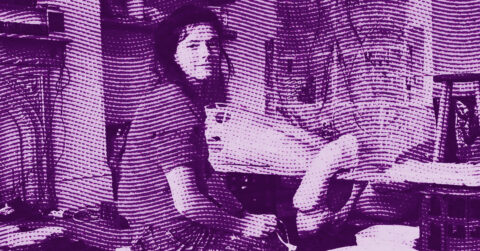Listen to me carefully, you bunch of snobs: here is an artist who, without fanfare or media noise, has been creating a work of remarkable coherence for more than three decades. Feng Xiao-Min, born in Shanghai in 1959 and living in Paris since 1988, offers us a painting that transcends cultural divides to reach a rare poetic universality. His canvases, saturated with light and space, testify to an authentic artistic quest, far from passing fashions and showy effects.
The man has traveled a singular path. Trained in the Chinese tradition of ink and calligraphy from the age of six, he then studied at the École Nationale Supérieure des Beaux-Arts in Paris, where he taught from 1997 to 2000 before dedicating himself exclusively to his creation. This dual training, far from being a handicap or a source of confusion, forms the foundation of his originality. Feng Xiao-Min does not seek to reconcile the irreconcilable, but to draw from each tradition what is most essential: the gestural fluidity of Chinese calligraphy and the chromatic richness of Western painting.
His recent compositions, exhibited at the Opera Gallery in New York under the title “Sailing Through the Light”, reveal exemplary artistic maturity. These twenty-six paintings, created between 2009 and 2025, show a constant evolution towards purification and a concentration of means. The artist has progressively abandoned descriptive titles for his works, preferring a simple chronological nomenclature that leaves free rein to the spectator’s imagination. This decision, seemingly innocuous, reveals a deep understanding of the pictorial act as a pure experience, freed from any narrative anecdote.
Bergsonian duration in the art of Feng Xiao-Min
The contemplation of Feng Xiao-Min’s works naturally evokes the thought of Henri Bergson and his revolutionary conception of time. Where traditional Western philosophy tended to spatialize time, to cut it into measurable and quantifiable instants, Bergson develops in his “Essays on the Immediate Data of Consciousness” [1] the fundamental notion of duration. This pure duration, accessible only through intuition, constitutes the lived time of consciousness, irreducible to the objective measures of science.
Feng Xiao-Min’s paintings seem to materialize this Bergsonian intuition. His canvases do not freeze a precise instant but capture the temporal flow itself. In “Composition N°6.4.23” (2023), the deep blues and warm ochres do not represent a determined landscape but the very experience of duration in front of the natural spectacle. The artist does not paint the object but the perception of the object, not the movement but the consciousness of movement. This approach perfectly aligns with Bergson’s critique of conceptual intelligence, incapable of grasping reality in its creative mobility.
Bergson distinguishes the spatialized time of science, a succession of juxtaposed instants, from true duration, the qualitative interpenetration of states of consciousness. Feng Xiao-Min makes a similar distinction between the traditional representation of the landscape, a catalog of identifiable elements, and his own approach, an intuitive fusion with the temporal essence of the natural world. His recent compositions, notably “Composition N°18.1.25” (2025), evoke less a sunrise than they restore the temporal quality of dawn, that particular duration when light gradually transforms our perception of space.
The creative act in Feng Xiao-Min proceeds by Bergsonian intuition. The artist does not intellectually construct his compositions but lets himself be carried by a creative impulse that follows natural rhythms. He states himself that each canvas demands a different time according to “mood, nature, temperature,” a mysterious process which he explicitly associates with Taoist philosophy and the balance of yin and yang. This controlled spontaneity corresponds exactly to what Bergson calls free action, one that emanates from the deep self without being determined by mechanical causes.
Feng Xiao-Min’s technique, who sometimes paints on the floor to control the flow of acrylic and water, concretely illustrates the Bergsonian primacy of intuition over analytical intelligence. The artist does not calculate his effects but accompanies the becoming of the pictorial matter, associating himself with the creative process rather than authoritatively directing it. This method aligns with the Bergsonian conviction that true knowledge does not result from applying pre-established concepts but from intuitive sympathy with the object of study.
The reception of Feng Xiao-Min’s works confirms this temporal analysis. Facing his canvases, the viewer experiences a dilation of present time, a slowing down of consciousness that allows access to the pure duration which Bergson opposes to the mechanized time of everyday life. Critics regularly highlight the calming effect of these compositions, their ability to create a space for meditation in a world dominated by technical acceleration. This therapeutic quality is not incidental but constitutive of Feng Xiao-Min’s art, faithful in this to the Bergsonian intuition of art’s role as a revealer of authentic duration.
The artist’s stylistic evolution, from his early works on rice paper mounted on canvas to his current compositions directly painted in acrylic, testifies to a maturation that perfectly embraces Bergson’s conception of creative evolution. Each stage of this journey does not destroy the previous one but incorporates it into a higher synthesis, according to the logic of the vital impulse that preserves the past while inventing the future.
The spirit of French romantic opera in contemporary painting
Feng Xiao-Min’s work maintains deep affinities with the aesthetics of 19th-century French romantic opera, particularly with the revolutionary spirit of Hector Berlioz. This kinship may be surprising as the artistic fields seem distant, but it reveals constants of French sensitivity in the face of the challenges of cultural modernity.
Berlioz, a composer misunderstood in his lifetime, develops in his lyrical works a revolutionary conception of total art that surpasses the academic conventions of his time. His “Troyens,” created only partially in 1863, propose an unprecedented synthesis between classical heritage and modern romantic expression [2]. This balancing act between tradition and innovation exactly characterizes Feng Xiao-Min’s approach, heir to Chinese calligraphy but inventor of a contemporary pictorial language.
The parallel becomes clearer when considering the critical reception of the two artists. Berlioz faces incomprehension from the Parisian musical establishment, dominated by Meyerbeer’s “grand opéra” and the conventions of the Opéra-Comique. His works, judged too innovative and insufficiently spectacular, find their audience only abroad, particularly in Germany. Feng Xiao-Min experiences a similar path: his first Parisian exhibitions of traditional Chinese works meet complete indifference from the French market, forcing him to radically rethink his artistic approach.
This resistance of the French artistic milieu to original aesthetic proposals reveals a sociological constant. Berlioz denounces in his critical writings the complacent mediocrity of French opéra-comique, a “temple of boredom and common pleasures” according to Théophile Gautier’s words. Feng Xiao-Min, more diplomatically, mentions cultural adaptation difficulties but the substance remains the same: true art disturbs bourgeois habits and requires patient work to educate the public.
Berlioz’s orchestration, with its harmonic innovations and explorations of new instrumental sounds, anticipates French musical impressionism. Feng Xiao-Min proceeds similarly in the pictorial field, developing a technique that borrows from Western impressionism its science of color while preserving the gestural fluidity of the Chinese tradition. His recent compositions, with their subtle play of transparencies and opacities, evoke the orchestral refinements of the “Symphonie fantastique” or “L’Enfance du Christ”.
The narrative dimension of romantic opera finds its equivalent in Feng Xiao-Min’s art. Although his paintings are officially abstract, they tell stories: the journey of light through the elements, atmospheric metamorphoses, cosmic cycles. The artist explicitly evokes the imagery of “boats sailing on infinite seas,” a reference that immediately calls upon the universe of great French romantic operas, from Rossini’s “William Tell” to Berlioz’s “The Trojans”.
This implicit narrativity aligns with the aesthetic of the French “grand opéra,” which favors dramatic effect over pure virtuosity. Feng Xiao-Min does not seek gratuitous technical feats but the creation of emotionally meaningful atmospheres. His paintings function as opera sets, imaginary spaces where the viewer’s reverie can unfold. The exhibition “Sailing Through the Light” thus transforms the gallery into a lyric theater, each composition constituting an act of this cosmic drama that the artist gives us to contemplate.
The influence of French romantic orientalism, from Delibes’ “Lakmé” to Saint-Saëns’ “Samson and Delilah,” also illuminates Feng Xiao-Min’s particular position in the contemporary artistic landscape. The 19th-century French opera develops an aesthetic of exoticism that does not merely reproduce orientalist clichés but attempts a true cultural synthesis. Feng Xiao-Min undertakes an inverse but complementary approach: an Eastern artist trained in the West, he offers us authentic orientalism, freed from European fantastic projections.
The spiritual dimension of Feng Xiao-Min’s art, explicitly linked to Taoism, joins the metaphysical aspirations of French romantic opera. Berlioz, in “La Damnation de Faust,” explores the territories of the absolute through a dramaturgy that surpasses the traditional religious framework. Feng Xiao-Min proposes a secular spirituality, accessible through pure aesthetic contemplation, which fits within this French tradition of art as a revelation of the sacred.
The accomplishment of a cultural synthesis
The art of Feng Xiao-Min today represents one of the most accomplished syntheses of East and West that Chinese artists emigrated to Europe have been attempting for more than a century. Where his illustrious predecessors Zao Wou-ki and Chu Teh-Chun paved the way, Feng Xiao-Min makes an original contribution through his ability to harmoniously integrate the achievements of several decades of intercultural experimentation.
His current technique, developed after twenty years of patient research, avoids the pitfalls of superficial syncretism. The artist does not juxtapose heterogeneous elements but creates an authentically new pictorial language, where Chinese calligraphic gestures naturally embrace Western chromatic richness. This technical success is only possible because it is based on a deep understanding of both cultural traditions.
The growing international recognition of Feng Xiao-Min, demonstrated by his representation in the global network of Opera Gallery and the museum acquisitions of his works, testifies to the relevance of this artistic pursuit. At a time when cultural globalization often produces standardized and identity-deprived works, Feng Xiao-Min’s art offers an alternative model: universality through the deepening of cultural particularity.
His most recent compositions, notably those from 2024 and 2025, reveal a new freedom in the use of bright colors and strong contrasts. This evolution, far from betraying his earlier research, logically extends it towards a more assertive expressiveness. The artist now fully embraces his dual cultural belonging to produce works of undeniable originality.
The poetic dimension of this painting is not a secondary effect but the natural consequence of the accuracy of the artistic approach. Feng Xiao-Min offers us images of the world that enrich our perception of reality without distorting it. This poetic authenticity, rare in contemporary art often dominated by provocation or concept, may be the most precious contribution of this discreet yet essential artist.
The work of Feng Xiao-Min reminds us that true artistic avant-garde does not consist in destroying the past but in regenerating it through a renewed contact with the living sources of creation. In this, it is part of the purest tradition of French art, from Cézanne to Matisse, while bringing the richness of a sensibility shaped by another civilization. This successful synthesis constitutes a model for 21st-century art, an era when cultural exchanges can no longer be content with decorative exoticism but must invent new, authentically universal languages.
- Henri Bergson, Essay on the Immediate Data of Consciousness, Félix Alcan, Paris, 1889
- Hector Berlioz, The Trojans, partial premiere at the Théâtre-Lyrique, Paris, 1863
















